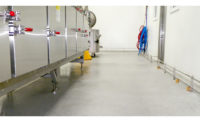The Benefits of Polymer Flooring in Dairy Processing Facilities

The floor area within a dairy farm or processing plant is subjected to a long list of damaging and deteriorating factors, such as traffic from rubber boots, cattle and forklift trucks, heavy machinery, lactic acid spillages and intense cleaning routines. Despite these challenging conditions, the floor finish needs to provide a clean platform that keeps both food products and employees safe.
All of the above routine factors can cause irreparable damage to an insufficiently protected surface, which will not only affect the movement of people, vehicles and animals, but it could also cause a dangerous hygiene risk. Contaminants can easily accumulate within difficult-to-clean joints or grout lines in the floor, an eventuality that increases the possibility of spoiled products, sick cattle, damaged reputations and a failure to meet the expectations of regulatory bodies.
The seamless finish of a resinous flooring system creates a shield against damaging factors that would compromise many alternative solutions, meaning that it will retain an easy-to-clean surface for an extended period of time. The robustness of a resin floor means that dairy plant operators can subject it to heavy impacts without concern for integrity. Should even further resilience be required, aggregates such as quartz sand, aluminum oxide and bauxite can be added to improve strength.
As resin floors are poured or trowelled in-situ, it removes the grout lines—which provide germs and mold spores with difficult-to-clean hiding places where they can colonize and accumulate—that affect traditional flooring choices such as tiles or brick.
The transition between the floor and the wall can be a prime site for dirt and grime to get trapped. Resin coving mortar creates a seamless transition between the two surfaces, covering up this potential hygiene hazard with an easy-to-clean layer. The coving system must be as durable as the floor, as it will encounter the same corrosives, heat and use.
Of the different types of resin flooring systems available, one of the most popular for dairy facilities is cementitious urethane. This material combines cement and water-based technologies, producing a mortar that is trowel-applied on-site to create a very strong finish.
The impervious nature of cementitious urethane helps to avoid bacterial contamination, as pathogens cannot seep into the floor and are easier to remove during cleaning. This solution is better than epoxy alternatives at resisting bacterial excretion on the floor, which is especially beneficial in areas of the dairy prone to contact with excessive amounts of fat, blood and dung.
The ability to incorporate antimicrobial additives within resinous flooring systems can help to further minimize the danger posed by bacteria to the produce and livestock.
Another significant advantage of cementitious urethane in a dairy facility is its highly effective resistance to thermal shock. This means that it won’t crack when subjected to extreme temperature changes, like hot water cleaning or blasts of cold air from freezers.
Cementitious urethane has a high cross-linked density, which makes it a good choice for areas that will be exposed to corrosive chemicals and is highly beneficial in a dairy where lactic acid is present in large quantities. In the milking areas, an epoxy floor would not be as effective, as the high level of organic chemical attacks and thermal shock would make it crack or de-bond.
Many dairies undergo cleaning sessions of 30-60 minutes after milking. If there are two or three milking sessions per day, then just cleaning the dairy can take up a significant amount of time and energy. If the floor is not strong enough, then these frequent washes will erode the surface layer and make a previously impervious floor porous and ineffective.
Unprotected concrete floors are especially at risk of deteriorating when faced with hot water cleaning that could eat into the surface layer. The harsh cleaning chemicals required to eliminate resilient microorganisms will also damage bare concrete over time, making it harder to clean.
Liquid from dung, cleaning fluids, lactic acid spillages and many other sources can create substantial excess water in a milking facility. Water ponding can be a serious hygiene concern, as it risks significant bacterial growth. A non-porous, well-drained floor is important to make sure that water does not stagnate and lead to unhygienic conditions.
A resin floor is impervious to water and facilitates rapid draining. This is especially important when coping with the large amounts of fecal matter that build up during milking, as blocked dung channels or long-standing effluence pose exceptionally dangerous hazards. For example, failing to remove soiling around the cattle’s feet and lower limbs can have a highly detrimental effect on the cow’s foot health and cleanliness levels, especially when manure is trampled into the cubicle. Properly sloped floors and stainless-steel drainage will help to quickly flush unwanted liquids and contaminants out of the area.
Contamination isn’t the only danger that can stem from excess water, as slippery conditions are a health and safety nightmare. Aggregates can be added into the mixture of a resin floor to enhance traction underfoot, creating an anti-slip surface. However, coarsely textured surfaces are harder to clean than smooth surfaces, so the ease of cleaning needs to be balanced against the level of grip required.
When assessing the on-site conditions, it is not just the main milking zone that needs to be considered, but also the storage rooms, staff areas, corridors and walkways. Epoxies are ideal for non-processing zones that are exposed to less rigorous operational activity.
The durability and functionality that can be achieved with resin flooring makes it a useful solution for dairy environments, where the floor will face a variety of challenges that can differ across the dairy complex. When choosing a floor finish, make sure to talk to the supplier and applicator to ensure that the finished surface will provide all the benefits required in that specific area.
Looking for a reprint of this article?
From high-res PDFs to custom plaques, order your copy today!





